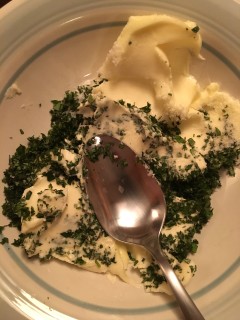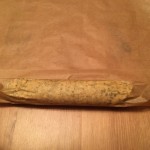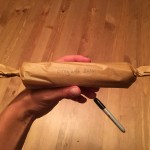Warning: Trying to access array offset on value of type null in /home/devonkarn/rootsnveggies.com/wp-content/themes/herothemetrust/functions.php on line 819
Compounding the problem: A bounty of herbs in butter

It’s early September. That tiny, cute sage plant you stuck in your garden three summers ago is now the size of a small ottoman, and gosh you feel like an asshole if you don’t use all those luscious, fresh herbs. Right? But one can only do so many summery dishes with sage, which you’re now realizing is better suited to winter foods (Stuffing! Squash!) that’ll come after your sage monster has frosted and died. I’ll be ok – just save a bunch of your herb babies for cool weather cooking by making and freezing compound butter now.
This stuff is incredibly useful. It preserves herbs’ character better than drying them, it uses plants you (or a friend) grew for free, and it has cooking fat and salt built right in. After freezing in stick-of-butter-sized logs, simply use a warm knife to cut a slice or two off as needed to elevate whatever you’re doing in the kitchen later. Melt a pat of chive butter into your mashed potatoes. Brown sage butter to sauce your butternut squash ravioli. Finish a steak with rosemary butter. Savory your grits. Excite your veggies. Make a roux with oregano butter and blow your mac and cheese or béchamel sauce out of the water. OH MY GOD make scones or pastry crusts with it (I just freakin’ thought of that!). Or just spread it on some toast. One million ideas here, people. Pair a roll of compound butter with a homemade loaf of bread (rosemary butter with cranberry bread, for instance), and make someone’s day with an inexpensive gift.
You’ll need:
- A stick of salted butter (fancy or plain), room temperature
- 1 1/2 Tbsp. finely chopped fresh herbs (sturdy ones like rosemary, sage, oregano, thyme, and chives work best)
- Parchment paper, waxed paper, or plastic wrap
Preparation:
- Put the softened butter and chopped herbs into shallow dish.

- Use the back of a spoon or a small, sturdy spatula to smush the herbs into the butter until they’re evenly distributed. Don’t be dainty about it, just get it done. If you’re multiplying the recipe and using more than one stick of butter (which you should, if you can), you might use a food processor to make quicker work of this. Add the herbs (stripped from their stems), pulse a few times till they’re coarsely chopped, then add the butter (cubed and a little colder than if you were folding herbs in by hand) and pulse until everything’s incorporated. If you find that the processor makes the butter too warm and runny, just stick the processor vessel in the fridge for a little bit to firm it back up.
 Tear off a sheet of wrap about 12 inches wide. Scoop out your compound butter in three or four evenly sized ploops and place them a few inches above bottom edge of your sheet. Fold the bottom edge up and sort of tuck/roll it over the butter, using the paper to create a tight tube. If you’ve rolled a joint or a cig, you know what I mean. If not, play around – you’ll get it. The goal is to form a smooth, tight, even log of butter using the paper as a mold.
Tear off a sheet of wrap about 12 inches wide. Scoop out your compound butter in three or four evenly sized ploops and place them a few inches above bottom edge of your sheet. Fold the bottom edge up and sort of tuck/roll it over the butter, using the paper to create a tight tube. If you’ve rolled a joint or a cig, you know what I mean. If not, play around – you’ll get it. The goal is to form a smooth, tight, even log of butter using the paper as a mold.- T
 wist the ends, label it, and stick it in the freezer. Once firm, it’s not a bad idea to put them in a ziplock bag; butter picks up other food flavors easily. Then get ready to have a tasty winter pulling from your butter gold mine.
wist the ends, label it, and stick it in the freezer. Once firm, it’s not a bad idea to put them in a ziplock bag; butter picks up other food flavors easily. Then get ready to have a tasty winter pulling from your butter gold mine.

2 Comments
Mary Elizabeth O'Connor
September 9, 2016I am impressed,
but I also failed to put that sage in the ground three years ago, Is there any hope?
Sharon Watson-Ambrose
September 9, 2016I just looked at your blog and I wanted to tell that your writing has a lyrical voice that paints a vivid picture and I truly enjoyed reading it, I look forward to making the compounding butter.